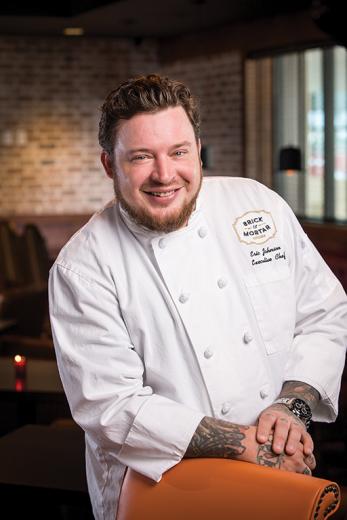1 16
1 16
“The farm-to-table movement will [include] not just chefs but all cooks...The mom and pop joints [too]...I think the supporting of the local microclimate will expand to the supporting of the American farmer in general, of sourcing not just from farms within 100 miles just to say ‘local,’ but searching out quality and artisan products from across the country.”
—Eric Johnson, executive chef, Brick & Mortar Kitchen, Houston
“…More bar-restaurant mashups and roaming restaurants—not just a pop-up, but brick-and-mortar restaurants doing more long-term trips abroad.”
—Thomas McNaughton, executive chef and partner, Ne Timeas Restaurant Group, San Francisco
“Good help in 2016 will be really expensive. Being a ‘chef’ or a line cook or working in a restaurant has become more or less like being in a band; at the end of the night there are free beers at the local bar and a cute girl who thinks your burns, lack of sleep, bitterness and tattoos are the sexiest thing ever. It could be leading to a generation of chefs with bad tattoos, no real skills and huge egos. Hence, why it has become so hard to find good help.”
—Jesse Barber, chef/partner, Dudley Market, Venice, CA
“More breweries inside restaurants. We’ve seen the number of craft breweries skyrocket in the South Bay in the past three years, and we don’t see it slowing down anytime soon.”
—Tin Vuong, chef/partner, Blackhouse Hospitality, Los Angeles
“Artisanal dairy products. I think people are going to get really into artisanal butters and yogurts and full fat ice creams, and will increasingly use raw and cultured milk products.”
—David Barzelay, chef, Lazy Bear, San Francisco
“Live wood fire cooking or open wood fire cooking. [Another] potential trend is what was once considered the basics…the restaurant making its own cheese, yogurt, cured meats, etc. I think it is a strange time now in gastronomy; the culinary world has lost its beacon on what is the ultimate. This disruption is great, and challenges the systems, but it does [make] us wonder what will stick and what is next.”
—Frank Mnuk, executive chef, Geraldine’s, Austin
“It’s an interesting time in America, where a lot of second-generation southeast Asians are entering their mid-30s… so we’re seeing a lot of trained cooks of immigrant parents starting to do the food of their cultural backgrounds, but in an environment that is on-trend.”
—Pawan Mahendro, chef/owner, Badmaash, Los Angeles
“Sustainable and alternative seafood, [given recent] studies about fraud and mislabeling of species, combined with a dwindling ocean population...Tickets: Direct-to-consumer sites like Eventful and ThunderTix are making it easy for smaller restaurants to utilize [tickets] for special events...Chef swaps: Look for your favorite restaurants to pack their bags for a weekend getaway next year.”
—Kim Canteenwalla, chef/co-owner, Honey Salt, Las Vegas
"Global street food is so much fun, which makes it perfect for restaurant menus featuring small plates. Most street food has great color, flavor and texture. It's also great for sharing, and most of the time, street snacks have a low food cost!”
—Akasha Richmond, owner, Sambar, Culver City, CA
“South Pacific cuisine: This is an amazing tasty cuisine that not many people know about though there are some restaurants exposing its true flavors such as Town restaurant in Honolulu.”
—Louis Tikram, executive chef, E.P. & L.P., Los Angeles
“The ‘Is this local?’ trend is more than just a fad, and it’s here to infiltrate the restaurant industry at all corners-fine dining to fast casual.”
—Andrew Ashmore, Roti Modern Mediterranean
“Rooftop gardens and micro-sustainability. Chefs are taking the eco-friendly on-site garden trend to the next level by recycling liquids from the kitchen (such as melted ice or water used to blanch vegetables) to cultivate the plants.”
—Michael Cimarusti, chef/owner, Providence, L.A.
“Chefs from both ends [fine dining and casual] will become more conscious of sustainable protein and produce, and menus will evolve with a higher focus on balanced health, and will have more emphasis on vegetables and seasonality...more artisanal techniques [including] in-house curing, pickling and smoking…cheaper cuts of meat which require a little more time and execution in the kitchen, but will demonstrate the chef’s creativity and ultimately [lower] food costs.”
—Chris Emerling, chef de cuisine, Bel Air Bar + Grill
“More vegetables [with] more personality…three to four course meals featuring regional produce… vegetarian options that are more technique-driven.“
—Collin Crannell, The Lobster
“Smartly executed ethnic dishes with ingredients and sources that are not familiar… Middle Eastern cuisine, [will trend] for the way it uses spices and condiments; it's very interesting and profound. I believe a lot of chefs will develop an interest toward it.”
—Hisashi Yoshiara, Estate Restaurant + Bar
“I believe most of the restaurant industry will be heading more to support local farmers for fresh, seasonal ingredients. The general population is becoming more and more conscientious of what they eat…Chef driven and local craft businesses are beginning to bloom. It’s an exciting time to be a chef! I’m thrilled to be a part of this movement and can’t wait to see where things will be in the next 10 years.”
—Julio Peraza, Proof + Pantry, Madrina

